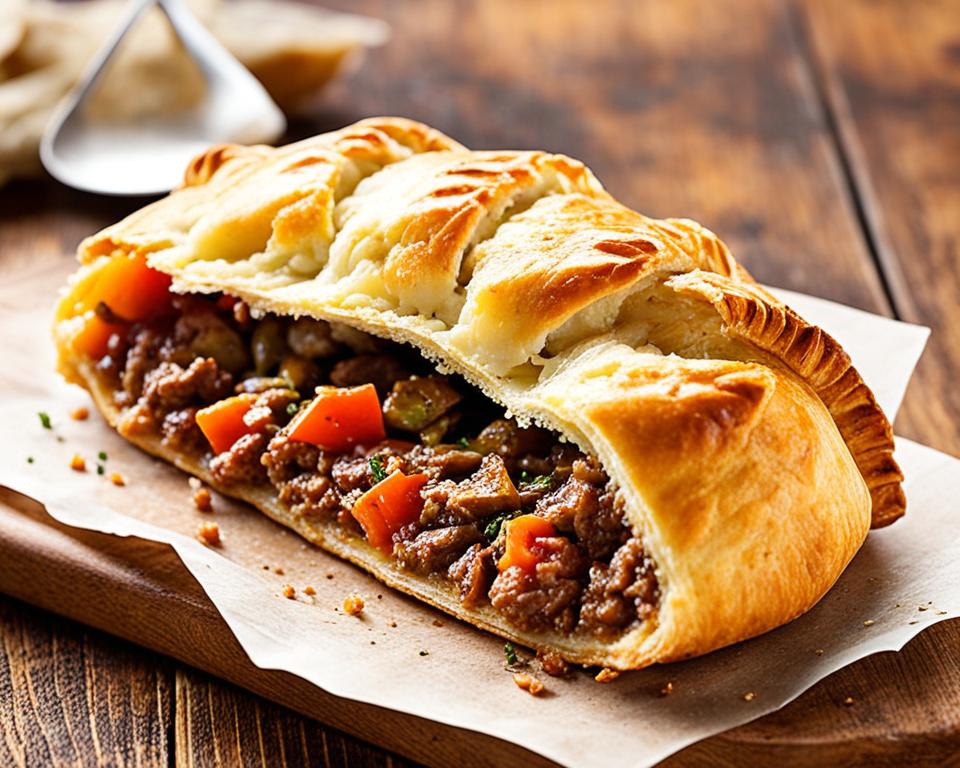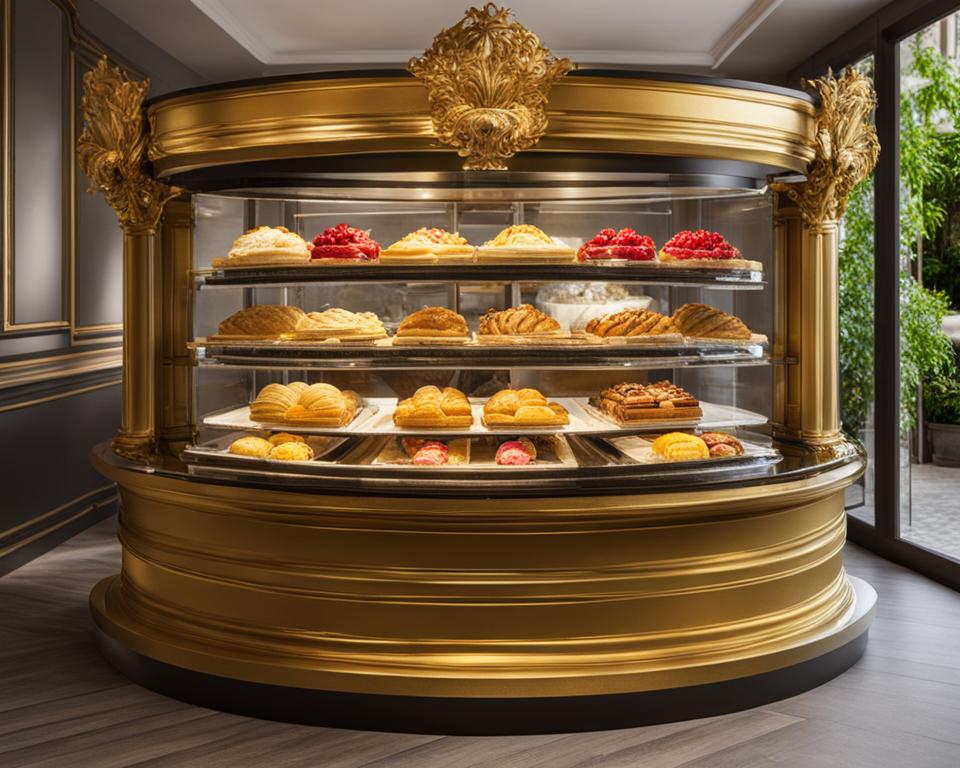Embark on a culinary journey through the scenic landscapes of Cornwall, England, with each bite of a homemade Flaky Cornish Pasty. An edible emblem of English comfort food, the authentic Cornish Pasty recipe is a delightful experience, offering a taste of history wrapped in a crumbly, buttery pastry. Food enthusiasts across America have embraced the tradition of this beloved dish, which features a satisfying mixture of beef and vegetables, cradled within a crispy Cornish Pasty crust, evoking the warm, rustic flavors of its native land.
Firmly rooted in the Cornish heritage, this savory pastry carries within its golden layers, stories of miners, family gatherings, and windswept coasts. Whether served at a family dinner or as a hearty snack, the Cornish Pasty recipe blends simple ingredients into sublime pleasure, ideal for those seeking to bring the essence of authentic English dishes into their own kitchens.
It is often said that the true essence of a culture can be savored in its traditional cuisines, and a homemade Cornish Pasty represents just that—a genuine slice of Cornwall’s rich culinary tapestry, filled with flavorful meat and nourishing vegetables, all enrobed in a flaky crust. With each pasty handcrafted with care and tradition, what emerges from the oven is not just a dish, but a celebration of heritage, ready to be enjoyed by comfort food aficionados in the comfort of their homes.
Key Takeaways
- Experience a classic English comfort food with a homemade Flaky Cornish Pasty, hailing from the coastal heritage of Cornwall, England.
- An authentic Cornish Pasty recipe features a harmonious blend of succulent beef and hearty vegetables wrapped in a naturally golden crust.
- The Cornish Pasty is a revered staple, celebrated for its historical roots among Cornwall’s mining communities and now cherished in American kitchens.
- Create your own culinary masterpiece with a Cornish Pasty recipe that balances tradition with homemade freshness and flavor.
- Indulging in a homemade Cornish Pasty not only nourishes the body but also connects food lovers to the storied culture of Cornwall.
The Rich History of Cornish Pasties
The traditional Cornish Pasty, a cherished emblem of Cornish Pasty heritage, has nourished generations with its hearty filling and flaky crust. This staple of English cuisine traces its Traditional Cornish Pasty origins to the rugged clifftops and deep mines of Cornwall, its history as rich as the savory contents within its golden pastry shell. Evocative of the Cornish miners’ food, the pasty’s practical design was pivotal to sustaining the workers in the harsh conditions of the tin and copper mines.
Stepping back in time, the pasty was a culinary innovation born out of necessity, featuring a thick, crimped crust that could be easily gripped by miners’ soiled hands. This ingenious handle served to prevent dirt and toxins—prevalent in mine environments—from spoiling the wholesome meal enclosed therein. A testament to its cultural resonance, the pasty was awarded the honor of both Protected Designation of Origin (PDO) and Protected Geographical Indication (PGI) status in 2011, a recognition that honors the traditional fabrication methods and ingredient profiles unique to the region.
A piece of Cornish history baked into every bite, the Cornish Pasty represents more than a meal—it signifies the enduring spirit of a community whose traditions have traversed time and geography to remain a beloved part of British culinary legacy.
To truly appreciate the pasty’s place in history, consider the following table, which outlines key historical milestones and cultural reflections that have cemented its status as a cornerstone of Cornish and British heritage:
| Historical Period | Cultural Significance | Culinary Impact |
|---|---|---|
| Pre-19th Century | Unrecorded origins, but believed to be a staple food for families in Cornwall. | Simple ingredients, reflecting the available local produce and meats. |
| 19th Century | Rise of tin and copper mining industries, pasty becomes the miners’ food of choice. | Robust design featuring a thick crust to be held by miners during meal breaks. |
| 20th Century | Global emigration patterns lead to Cornish pasty popularity in other mining communities worldwide. | Recipe and techniques passed down through families, with variations emerging. |
| 21st Century – 2011 | Recognition of the Cornish Pasty’s integral role in the cultural heritage leads to PDO and PGI distinction. | Strict guidelines are set to safeguard the quality and traditional characteristics of the pasty in commercial production. |
As the appetite for discovering and savoring historical dishes grows, the Cornish pasty continues to be championed by both culinary enthusiasts and those who seek to honor the groundwork laid by the Cornish miners. It remains a vivid reminder of a time when food was as much about sustenance as it was about identity and community.
Unearthing the Cornish Pasty’s Cultural Significance
Delving into the essence of English comfort food, one cannot overlook the Cornish Pasty—a dish steeped in Cornwall’s tradition and gastronomic pride. The Cornish Pasty stands as an ambassador of Cornwall’s culinary identity, echoing through time the practices and landscapes that shaped its making.
A Staple in Cornwall’s Tradition
Embraced as the quintessential Cornish meal, this savory pastry epitomizes Cornwall’s tradition of simple, hearty fare. Originating from the rugged terrains of southwest England, the Cornish Pasty encapsulates a legacy of communal dining, conviviality, and cultural richness, making it an integral part of the local fabric of life.
Protected Designation of Origin and Geographical Indication
In recognition of its cultural and historic value, the Cornish Pasty has been honored with the Protected Geographical Indication (PGI) status. This esteemed label ensures that the traditional methods and precise ingredients used in its creation are protected, preserving the authenticity of the pasty for future generations.
With its PGI status, the Cornish Pasty is safeguarded by stringent guidelines that stipulate the inclusion of specific raw ingredients and a traditional slow baking method—all to capture the aroma, texture, and flavor that have enamored diners for centuries.
The adherence to these Protected Designation of Origin guidelines is more than ceremonial; it is a testament to Cornwall’s commitment to its heritage. This includes the use of locally sourced beef, potato, and Swede, combined under the experienced hands of pasty makers who honor the centuries-old tradition.
The result is not just a meal but a culinary heritage piece that carries forward Cornwall’s historical tapestry within its golden, flaky exterior. Let us further explore how this humble dish achieved its culinary stature and become an iconic symbol of English comfort food.
An Authentic Flaky Cornish Pasty Recipe
Embark on a delightful venture into the world of English comfort food with this comprehensive Cornish Pasty making tutorial. A true labor of love, the authentic Flaky Cornish Pasty comes alive through steps that fuse the best Cornish Pasty filling with the mastery of a crispy Cornish Pasty crust, promising an enchanting blend of flavors and textures. Under the hands of a diligent cook, raw beef harmonizes with tender potatoes, earthy Swede, and aromatic onions, wrapped meticulously in a pastry that epitomizes the art of British baking.
The journey to creating the perfect Cornish Pasty is one of precision and tradition. The aesthetics of the dish, including its golden crust, is only surpassed by its rich taste and satisfying texture. With a filling that caters to the most discerning of palates, this beloved dish embodies the heart of Cornwall with every bite. For those eager to delve into this culinary craft, the following guide provides a step-by-step approach to making the authentic Pasty, reflecting the dedication and skill required to produce this celebrated British delicacy.
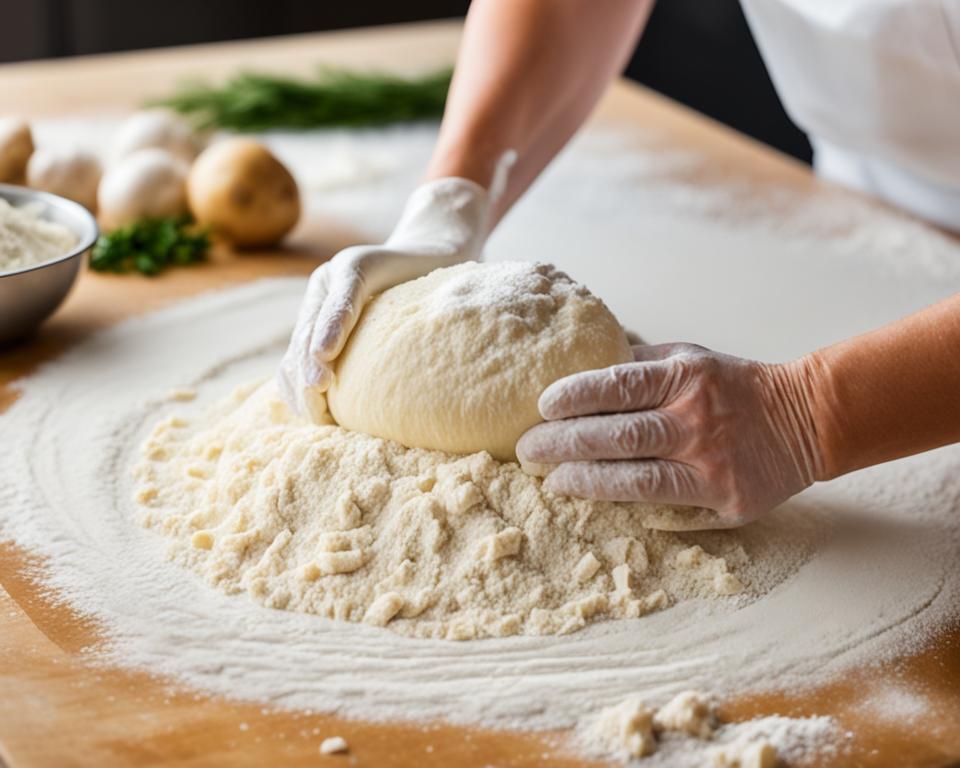
- Begin with the pastry: The foundation for any great Pasty is its distinctive crust. Achieving that perfect flakiness requires keeping all ingredients cool and handling the dough with care.
- Selecting quality ingredients: The best Cornish Pasty filling starts with skirt steak for tenderness, and the perfect ratio of Swede to potato for bulk, binding them gently with seasoned onions.
- Assemble with precision: Layer the thinly sliced vegetables and beef onto the rolled-out dough, leaving ample space along the edges for sealing.
- Seal and crimp: The hallmark of an authentic Pasty is its characteristic crimp along the curve, creating a seal that locks in flavor and ensures a crispy Cornish Pasty crust after baking.
- Bake to perfection: Timing and temperature are vital, as they leap from the edges to the heart of the Cornish Pasty, enveloping it in warmth and turning it golden brown.
This traditional recipe not only meets the taste expectations but also honors the culinary heritage that is inherent to Cornwall. Faithful to the classic preparation methods, this Cornish Pasty making tutorial is designed to guide food lovers through the process of crafting a pasty with utmost respect for its origins. Aspiring bakers are sure to find joy in the creation of these handheld treasures and delight in the home-cooked excellence that is born from their ovens.
To ensure a consistent outcome, consider the following tips:
- Always use cold butter for the pastry; this is essential to achieving that desirable flakiness.
- For the filling, remember that seasoning is everything. Salt and pepper bond with the natural juices of the beef and vegetables, elevating their flavors.
- Patience is key when crimping; this is what seals your masterpiece and creates that signature look.
- Bake until the pasties are a lush golden color, a sign that the inside is cooked to tender perfection, delivering that crispy Cornish Pasty crust we all desire.
Embracing this recipe will undeniably offer a genuine taste of Cornwall, in your own kitchen. The simplicity and humility of a Cornish Pasty’s ingredients, enveloped in the perfect pastry, speak volumes to its enduring appeal. Whether for a cozy meal indoors or a hearty takeaway on a brisk day, this staple dish continues to win over hearts one pasty at a time.
Meticulous Ingredient Selection for Perfect Cornish Pasties
Creating the quintessential Cornish Pasty begins with the deliberate choice of premium, traditional ingredients. A discerning palate can detect the difference that high-quality components bring to this classic recipe. A carefully curated list of Cornish Pasty ingredients not only ensures authenticity but also enriches the overall flavor profile of the dish.
Choosing the Right Cut of Beef
At the heart of a Cornish Pasty’s robust flavor is the lean cut of beef. A top-tier selection in the arena of Cornish Pasty ingredients, skirt steak stands out for its balance of leanness and rich taste. It’s vital to source this beef cut for its ability to impart a succulent, melt-in-your-mouth texture, making each bite of the pasty a memorable occasion.
The Significance of Swede and Potato
Complementing the delectable skirt steak are the humble yet indispensable vegetables – Swede and potato. Both are renowned for their consistency and ability to maintain structure during the slow baking process. Not any tuber will do; firm, waxy potatoes and the sweet, earthy Swede are selected for their contribution to a comforting and hearty meal that captures the essence of Cornwall with each morsel.
In truth, these components are more than just fillers; they are a canvas that carries the seasonings, melding with the juices of the skirt steak to create a symphony of flavors, distinctive to the Cornish Pasty. Below is a table that outlines the key Cornish Pasty ingredients that any pasty enthusiast should incorporate into their recipe to achieve the hallmark of Cornish culinary tradition.
| Ingredient | Role in Pasty | Culinary Benefit |
|---|---|---|
| Skirt Steak | Main protein source | Provides tenderness and rich flavor |
| Potato (Waxy Variety) | Bulk and texture | Retains structure and complements beef |
| Swede (Rutabaga) | Bulk and sweetness | Adds a mild sweet note and retains form |
Adhering to these ingredient standards is not about culinary elitism; it’s about honoring a time-honored process that pays homage to the Cornish culture. As each element comes together to form the Cornish Pasty, they carry forward the tradition of communal sharing and simple yet profound enjoyment of food that has been a mainstay in Cornwall for generations.
Crafting the Crispy Cornish Pasty Crust
The quest for the ideal crispy Cornish Pasty crust is steeped in the tradition of fine baking, where mastering the art of shortcrust pastry is essential. Achieving that sublime flakiness in pastry calls for dedication and adherence to time-honored techniques, ensuring that each Cornish Pasty emanates the rustic charm and comforting warmth of Cornwall’s culinary landscape.
Secrets to Achieving Flakiness
Behind every mouthwatering bite of a Cornish Pasty lies the secret to its flaky success: a perfectly prepared shortcrust pastry. The delicate crumb and crisp texture hinge on the art of balance—using the right fats, maintaining them at optimal temperatures, and incorporating them into the flour with a featherlight touch. Buttery richness is a calling card for this dough, making it crucial to select a high-quality butter that lends both flavor and layers to the pastry.
To help ensure these results, it’s imperative to keep all the ingredients, especially the butter, as cold as possible. This prevents the development of gluten, which can make the pastry tough. Additionally, overworking the dough is a common pitfall; gentle and just enough mixing is key. Lastly, allow the dough to chill adequately before rolling to relax the gluten and ensure it doesn’t shrink during baking, thus contributing to the sought-after flakiness in pastry.
Rolling and Shaping Techniques
When it comes to shaping a legendary Cornish Pasty crust, the rolling and shaping stages are foundational elements. With a chilled and rested dough, a gentle but assured hand is required to roll it out to the desired thickness. The thickness of the pastry correlates directly to the crispiness and flakiness of the final crust—too thick and it could become chewy; too thin and it risks breaking apart.
Professional pasty crafters will tell you that once the pastry is adequately rolled, one must be artful in draping it over the filling, ensuring it encompasses every savory component without tearing. The crimping edges must not merely be functional; they should be sculpted with precision to create the traditional Cornish pattern that is recognizably artisanal.
- Keep rolling even and uniform for a consistent bake and texture.
- Use guides or templates for cutting out pastry circles to maintain uniformity among pasties.
- Remember, practice makes perfect, and each attempt will bring you closer to the ideal crust—one that is as pleasurable to the eyes as it is to the palate.
Constructing Cornish Pasties: A Step-by-Step Guide
Discover the traditional art of pasty assembly with this Cornish Pasty making tutorial. This step-by-step guide ensures that each ingredient is expertly layered, seasoning is perfected, and the pastry is sealed and crimped to capture the heart of Cornwall’s culinary legacy. Whether you’re an experienced baker or trying your hand at these savory delights for the first time, this guide promises to lead you toward creating golden, flaky pastries brimming with flavor. Let’s begin our journey through the classic steps to construct the perfect Cornish Pasty.
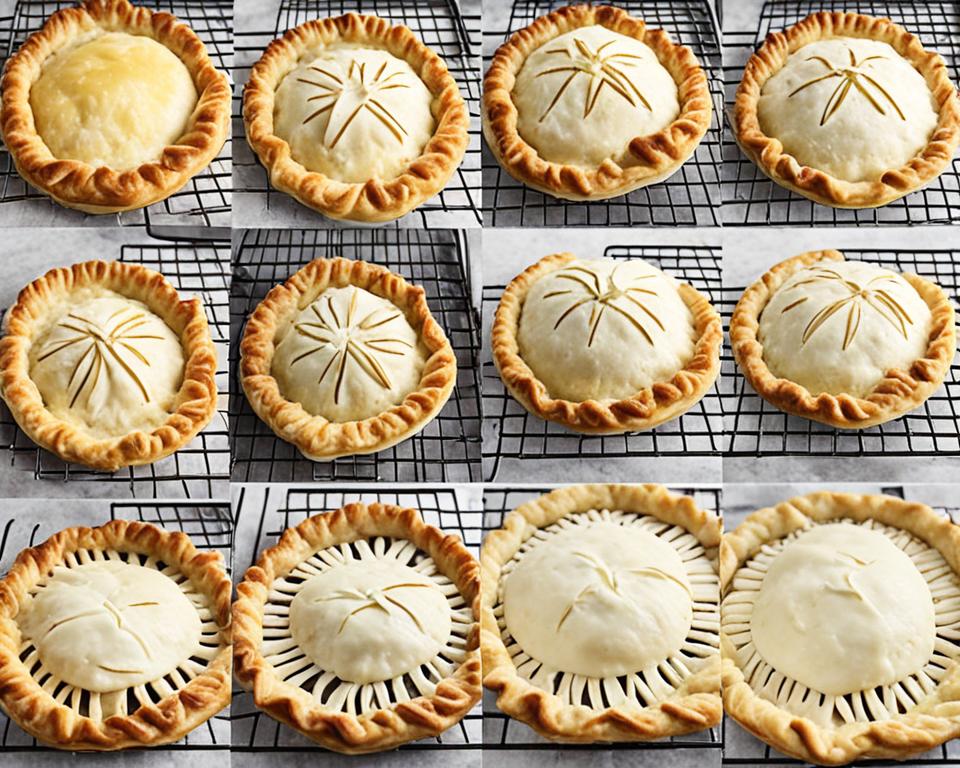
- Prepare the Dough: Firstly, combine flour and butter to create a crumbly texture. Gradually add cold water to form the dough, then refrigerate for optimal pliability.
- Lay the Foundation: On a floured surface, roll the dough into an even circle approximately 1/8 inch thick, which will serve as the base of your pasty.
- Choose Your Fillings: Traditionally, skirt steak, potato, swede (rutabaga), and onion are chopped into uniform pieces and kept raw for slow cooking inside the pastry.
- Season Each Layer: Sprinkle salt and pepper between layers of the vegetable and meat to enhance the natural flavors and aid in gravy formation during baking.
- Form the Gravy: Add butter on top of your filling, a tip that not only enriches the filling but also aids in creating a savory, thick gravy within.
- Master the Seal: Moisten the edges of the dough for a secure seal. Fold over the dough to envelop the filling, pressing down to remove any trapped air.
- Crimping for Perfection: Using the traditional Cornish technique, crimp the edges to ensure they hold during baking while also adding a decorative touch.
- Ready for the Oven: Once sealed, make a small slit on top of each pasty to allow steam to escape, brush with an egg wash for color, and place on a baking tray ready for the oven.
- Bake to Golden Glory: Bake in a preheated oven until the pasties are golden brown, ensuring that the insides cook to tender perfection.
With these steps, you are well on your way to mastering traditional pasty assembly. Remember, patience and attention to detail are key to achieving that characteristic flaky texture and richly savory filling that Cornish Pasties are known for. These methods, when followed with care, will allow anyone to produce authentic Cornish Pasties, ready to transport tastes buds straight to the heart of Cornwall.
Mastering the Traditional Cornish Crimping Method
Achieving the perfect Cornish Pasty encompasses more than just combining the right ingredients; it demands proficiency in the traditional Cornish crimping technique. This methodical folding and sealing practice not only dictates the pasty’s structural integrity but also its aesthetic charm. Aspiring pasty makers mustn’t overlook this intricate step, as it’s the hallmark of an authentic Cornish pasty experience. The meticulous art of pasty edge sealing is both an act of preservation and a nod to the pasty’s storied legacy.
The Art of Edge Sealing
An expertly crimped pasty edge does more than simply contain its hearty filling; it evokes a profound sense of tradition and care invested in every fold of the dough. The sealed edges are the primary defense against the hearty filling’s escape during the baking process, crucial for that impeccable, leak-free result. Cornish Pasty crimping not only requires a steady hand but also an understanding of the pasty’s functional requirements – to create a durable and portable meal that could withstand the tribulations of a miner’s lunchbox.
Creating the Iconic Cornish Look
The distinctiveness of a genuine Cornish pasty can largely be credited to its iconic, crimped silhouette. Employing the traditional Cornish technique, bakers craft a braid-like pattern along the edge of the pasty, a practice that’s both visually captivating and indicative of a well-made pasty. This isn’t merely for allure; it conveys a centuries-old practice of pasty edge sealing, a signature of Cornish heritage that has traversed generations.
Advancing from mere practicality, the crimped edges of these pasties are a symbol of Cornish craftmanship. For those committed to authentic recreations, nailing this technique is crucial. The results? A pasty that sits as proudly on the plate as it does in the pantheon of British culinary classics.
“A perfectly crimped Cornish pasty is a homage to Cornwall itself – every fold a story, every bite a history lesson in this cherished regional fare.”
Homemade Cornish Pasty Filling Variations
While the traditional Cornish Pasty is a staple of English comfort food, modern culinary enthusiasts have begun to explore Cornish Pasty variations that offer a contemporary twist on the classic. True to the innovative spirit of Cornwall, pasty creators are discovering new ways to enjoy this hearty dish.
Innovating While Honoring Tradition
Traditional filling innovation isn’t about straying from the roots; it’s about building upon the foundation of the classic recipe. Experts in the genre have created variations that incorporate seasonal vegetables, an array of cheeses, and even vegan options to cater to diverse dietary preferences. These inventive fillings still encapsulate the essence of Cornish culture, with each variant capturing the comforting allure of the original.
Sweet Meets Savory: Dual Filled Pasties
Among the most striking innovations have been the creation of dual filled pasties. These sweet and savory pasties are partitioned into two sections, one housing the succulent, savory staples of meat and vegetables and the other surprising the palate with sweet fruits or sumptuous dessert fillings. This design reflects the ingenuity of pasty makers and a seamless blend of flavors that makes the Cornish Pasty a versatile participant in the modern culinary scene.
The Cornish Pasty demonstrates the zest for life that the people of Cornwall have always had, opening doors to endless tasty possibilities.
Exciting developments in filling options have been celebrated by patrons and connoisseurs alike, as they pay respect to the legacy of Cornish cuisine while elevating it to impressive new heights. Whether you stick to the roots or venture into the realm of Cornish Pasty variations, each pasty created is a testament to culinary artistry and cultural resonance.
Preserving the Pasty: Freezing and Reheating Tips
Ensuring that your Cornish pasties retain their delicious flavors and textures after freezing is essential for any pasty enthusiast. Freezing Cornish pasties is a convenient way to store these savory treats for later enjoyment, while proper reheating preserves the fresh-baked quality. Whether you’re preparing a batch in advance or saving leftovers, follow these instructions to maintain pasty quality from the fresh pasty aroma out of the oven to the last satisfying bite at your table.
Freezing and Baking Instructions
To freeze Cornish pasties, either before or after baking, wrap each individual pasty tightly in plastic wrap. Then, place them in a heavy-duty freezer bag to prevent freezer burn. For unbaked pasties, direct transfer from freezer to oven is the best way to preserve the pastry’s flakiness; simply adjust the baking time to accommodate the thawing process, adding approximately 15-20 minutes to the usual baking time. If the pasties are already baked, thaw them in the refrigerator before reheating to ensure even warming throughout.
Ensuring Quality: From Oven to Table
Reheating your pasty properly is a pivotal step to revive that freshly baked taste. Reheat baked and thawed Cornish pasties in the oven at a reduced temperature to return the crust to its original crispy state. Here’s a simple method to ensure that reheated pasties are as good as the day they were made:
- Preheat your oven to a moderate temperature, around 350°F (175°C).
- Place the thawed pasties on a baking sheet lined with parchment paper for easy cleanup.
- Heat for about 15-20 minutes, or until the pasties are thoroughly warmed through and the crust is crispy.
Alternatively, for a quicker method, you can use the microwave. While this won’t maintain the crispness of the pastry as well as the oven, it’s a convenient option for those short on time. Microwave each pasty on a microwave-safe plate in 30-second intervals until the desired temperature is reached.
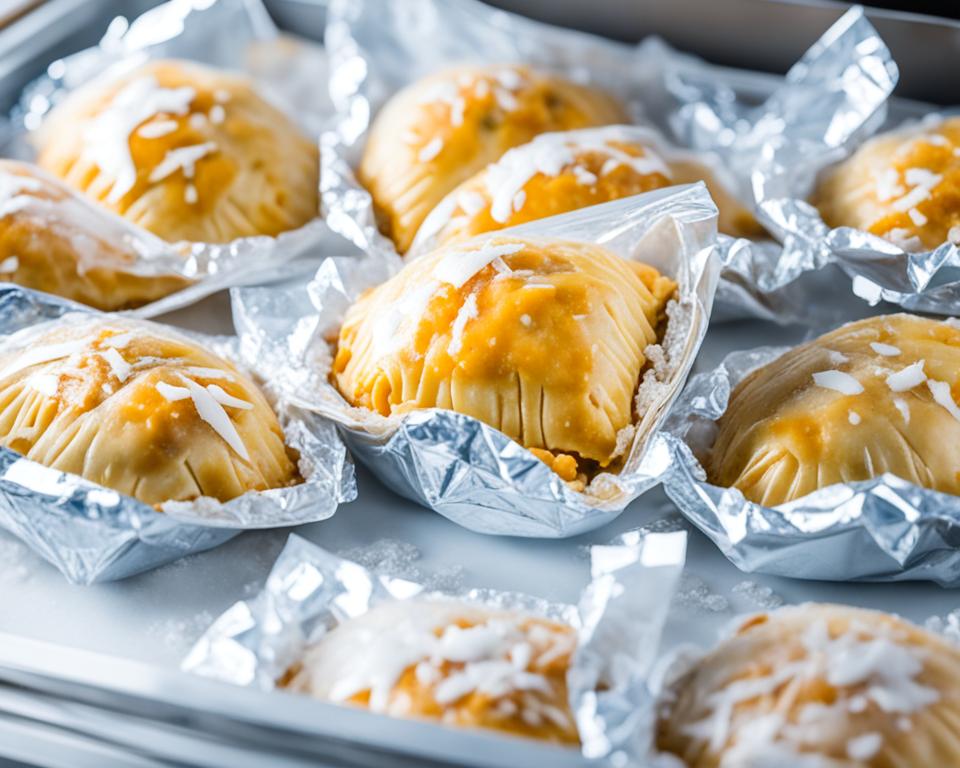
Keep in mind, whether you’re reheating a single pasty or a full batch, attention to detail will ensure that every Cornish pasty you serve will offer that delightful combination of a flaky crust and a warm, flavorful filling that makes them so irresistible.
Baking the Quintessential Cornish Pasty
Baking Cornish Pasties is more than an activity; it’s an art that requires precision and a clear understanding of the elements that contribute to creating this beloved staple. Discovering the perfect pasty temperature and timing is essential for that ideally flaky and golden crust with robustly flavorful fillings.
Temperature and Timing for Excellence
The secret to the perfect Cornish Pasty lies in the baking process. Achieving that golden hue and delectable crust texture begins with understanding the perfect pasty temperature. Here’s a guide to ensure your pasties are baked to perfection:
- Preheat your oven to a robust 425°F (220°C), providing the initial heat needed to start the baking process with a sizzle.
- Once the pasties are introduced, reduce the temperature after 15 minutes to 350°F (175°C) to allow for a slower and even bake.
- Continue baking for 45 minutes or until you observe the unmistakable golden-brown crust that characterizes a properly cooked Cornish Pasty.
- Keep an eye on the pasties as oven temperatures can vary; adjust cooking time accordingly to ensure the filling is thoroughly cooked, and the pastry is perfectly crisp.
Serving Suggestions and Pairings
When it’s time to indulge in your freshly baked Cornish Pasties, consider these Cornish Pasty serving suggestions to elevate the meal:
- A simple green salad with a light vinaigrette complements the richness of the pasty without overshadowing it.
- For a heartier meal, pair your pasty with seasonal roasted vegetables or a creamy mashed potato side.
- A pint of ale or stout makes for a traditional pairing, pulling the distinct flavors together in a truly British culinary experience.
Whether served as a standalone treat or as part of a more elaborate meal, the Cornish Pasty makes for a fulfilling and comforting dish. Remember to allow the pasties to cool slightly before serving, as this will enhance their texture and flavor, and keep the filling from being overly hot. Embrace the rich history and indulgence of traditional English cuisine by enjoying a Cornish Pasty, baked to perfection, as the center of your dining experience.
Learn from Cornish Locals: Insider Tips for the Best Pasties
Steeped in tradition and bursting with flavor, the Cornish Pasty is a craft perfected by the community that brought it to fame. Locals in Cornwall have preserved the artistry and historical significance in every hearty pasty they crimp and bake. It’s from these experienced hands that we gather insider pasty knowledge, gaining insight into the subtleties that define an authentic pasty experience.
Gathered from the rolling hills and rugged coastline of Cornwall, these Cornish local tips are not merely suggestions but ancestral secrets passed down through generations. They are the whisperings of the past, bearing witness to the timeless allure of this beloved dish. Here are some coveted traditional Cornish Pasty advice to transform your pasty-making experience:
- Start with Quality Ingredients: Locals stress the importance of using fresh, locally-sourced produce whenever available. From the robust flavor of the skirt beef to the earthy tones of the rutabaga, quality shines through in every bite.
- Keep Everything Cool: Ensure your hands, working surface, and all ingredients remain cool during the pastry-making process to achieve that prized flaky crust.
Here’s a local’s guide on how to bring all these elements together:
- Rolling the Dough: Aim for dough that’s not too thin to become fragile, nor too thick to turn chewy. An even, 1/8-inch thickness is often recommended.
- The Right Fill: While the traditional filling is non-negotiable, the way in which you chop and layer your ingredients can have a substantial impact. Fine chopping can lend more flavor, while coarser cuts provide a hearty texture.
- Crimping with Care: Each pasty should be sealed with the crimp on the side, not the top. This method is not only traditional but also practical, offering a sturdier structure for the filling.
- Slow and Steady Baking: Rushing the process won’t do. A moderate oven allows the pasty to cook from the inside out, avoiding undercooked fillings or overdone crusts.
Let’s break down these tips into detailed aspects that affect the final taste and texture of this Cornish classic:
| Aspect | Local Insight |
|---|---|
| Pasty Crust | The balance of a shortcrust pastry should be just right – not too flaky, not too hard – the hallmark of a proper Cornish Pasty. |
| Filling Consistency | Season beef and vegetables well but do not over-stuff; too much filling can result in a ruptured pastry. |
| Seasoning | Generations agree that it’s the simple combination of salt and freshly ground pepper that complements the natural flavors of the ingredients. |
| Baking Duration | Patience is key – the slow baking process develops depth of flavor, a trait Cornish locals swear by. |
Heeding these tips is a nod to the heritage and skill of pasty-making, ensuring that each creation is not just satisfying in taste but rich in Cornish lore. Engage in this culinary tradition, embrace the pasty etiquette, and enjoy a dish that goes far beyond mere sustenance – a piece of cultural pride that comes through with every savory bite.
Exploring Regional Cornish Pasty Shops and Traditions
The heart and soul of Cornwall, the Cornish Pasty, has made its indelible mark on the culinary map, with pasty shops dotting the region and preserving the essence of this traditional fare. An exploration into these regional Cornish Pasty shops lays bare a rich tapestry of history and flavors, each establishment serving as a custodian of time-honored pasty traditions.
Championing Local Cornish Eateries
Local Cornish eateries form the backbone of regional pasty traditions, with each shop boasting its unique recipe handed down through generations. These family-run establishments pride themselves on traditional techniques, continuing to feature the classic beef and vegetable filling enveloped in the iconic flaky pastry crust—a testament to the unchanging appeal of this beloved dish. It is in these eateries that one finds the true Cornish Pasty, meticulously crimped and satisfyingly hearty, delivering a culinary experience steeped in history.
Adapting Pasty Recipes Across America
As the Cornish Pasty continues to captivate taste buds beyond the shores of the United Kingdom, American adaptation of pasties has resulted in an exciting culinary fusion. While maintaining the rustic charm of the original, American pasty enthusiasts have embraced a plethora of fillings and interpretations, ensuring that each bite still pays homage to the Cornish legacy. From classic eateries to modern gastro-pubs, the pasty has found a new home in America, where creative chefs and home bakers alike are crafting their take on the Cornish classic, bridging the gap between tradition and innovation.
Firmly entrenched in the fabric of Cornish culture, the pasty’s journey from regional specialty to international sensation reflects a growing appreciation for simple, yet profoundly satisfying, hand-held comfort food. It is this recognition of pasty-making as both an art and a tradition that has led to the rise of numerous Cornish Pasty shops across the United States, each offering a slice of Cornwall’s culinary legacy.
Crowning Your Meal with a Homemade Cornish Pasty
As the final touch to a sumptuous spread, the homemade Cornish Pasty stands triumphant. Celebrated as a paragon of hand-crafted comfort food, its crumbly crust enfolds a hearty mix of beef, potato, and turnip in a warm embrace, rendering just one bite evocative of the undulating hills and Celtic charm of Cornwall. This is more than food; it’s a narrative of culinary craft, a vessel of comfort carrying stories across tables and generations.
The Satisfaction of Hand-Crafted Comfort Food
The act of crafting a homemade Cornish Pasty from scratch, with diligent hands shaping the careful crimps, stokes a profound sense of accomplishment. This is the cuisine that spells love in every precisely folded edge, with aromas that fill the kitchen, whispering of a heritage both robust and tender.
Creating Lasting Memories with Every Bite
Each homemade Cornish Pasty is an opportunity to engender lasting culinary memories. It’s an edible heirloom, a tradition gathered around the fire of the hearth. For all who partake, it’s an experience that goes beyond mere sustenance, imbuing moments both everyday and extraordinary with a richness that lingers long after the final morsel is savored.
Conclusion
As we reach the culmination of our culinary exploration, the Perfect Flaky Cornish Pasty stands not just as a traditional English recipe, but as an emblematic celebration of Cornwall’s rich gastronomic tapestry. The journey to perfecting this dish is one imbued with the cultural essence of a region famed for its robust flavors and hearty comfort food. These pasties are not merely a meal but an evocative experience in craft and devotion, a delight that beckons the senses to the moorlands and heritage of Cornwall.
Every homemade Cornish Pasty, with its tender filling and flaky embrace, serves as a tribute to the miners, the families, and the Cornish artisans of yore whose culinary practices have withstood the tests of time. They’ve passed from generation to generation, carrying forth a legacy that today finds its place not only in the kitchens of Britain but in homes across the United States. For lovers of traditional English recipes, the Cornish Pasty is a badge of authenticity and a cherished centrepiece of any meal that celebrates the piquant joys of simple, savory food.
In essence, the Cornish Pasty is more than food—it’s Cornish comfort food at its finest. It connects us to a culture steeped in history, unites us around tables laden with love, and, with each bite, revivifies the stories of Cornwall’s storied past. For the home chefs and food aficionados alike, creating the Perfect Flaky Cornish Pasty is to partake in a tradition that feeds not just the body, but also the soul.
FAQ
What is a traditional Cornish Pasty?
A traditional Cornish Pasty is a savory pastry from Cornwall, England, filled with raw beef, potato, Swede (rutabaga), and onion, seasoned and baked until golden brown.
What makes the Cornish Pasty crust flaky?
The flakiness of the Cornish Pasty crust comes from a well-made shortcrust pastry, which requires keeping the butter cold, not overworking the dough, and adequate chilling before rolling and folding.
How do I select the best cut of beef for a Cornish Pasty?
A lean cut like skirt steak is ideal for a Cornish Pasty because it offers both tenderness and a robust flavor that complements the other ingredients.
What is the significance of Swede in a Cornish Pasty?
Swede, also known as rutabaga, is a traditional ingredient that adds a sweet, earthy flavor to the pasty and holds its shape well during the baking process.
Can you provide a Cornish Pasty making tutorial?
Yes, a Cornish Pasty making tutorial includes a step-by-step guide on preparing the pastry, layering the ingredients, seasoning, crimping, and baking the pasty.
What is the proper technique for crimping a Cornish Pasty?
Crimping involves sealing the edge of the pastry by twisting or folding it over itself, ensuring a tight seal to encapsulate the filling and prevent leakage during baking.
Are there variations to the classic Cornish Pasty filling?
While the classic filling includes beef, potato, Swede, and onion, variations exist, such as vegetarian options and creative pasties with dual sweet and savory compartments.
How do you keep a Cornish Pasty crispy when reheating?
To keep a Cornish Pasty crispy when reheating, it’s best to use an oven to warm it through, which helps preserve the pastry’s texture.
What are some serving suggestions for a freshly baked Cornish Pasty?
A freshly baked Cornish Pasty can be enjoyed on its own, with a side salad, or with a pint of ale or cider to complement its hearty flavor.
How do local Cornish tips influence the quality of homemade pasties?
Local Cornish tips often involve traditional techniques and family secrets that enhance the flavor and authenticity of homemade pasties.
Why is the Cornish Pasty considered English comfort food?
The Cornish Pasty is considered English comfort food due to its rich, savory filling wrapped in a buttery pastry, providing a hearty and satisfying meal that’s perfect for warming up any day.
Can you freeze Cornish Pasties?
Yes, Cornish Pasties can be frozen either before or after baking, and it’s important to wrap them well to prevent freezer burn and maintain their quality.
How are American adaptations of the Cornish Pasty different?
American adaptations of the Cornish Pasty might include different fillings to suit local tastes or incorporate regional ingredients, while still trying to respect the essence of the traditional recipe.
What is the Protected Designation of Origin status for Cornish Pasties?
The Protected Designation of Origin status for Cornish Pasties is a certification that protects the authenticity of the pasty and ensures that only pasties made in Cornwall according to specific standards can be labeled as Cornish.
Can I make Cornish Pasties at home?
Absolutely! Making Cornish Pasties at home is not only possible, but it also allows for a personal touch to this culinary classic. It’s a gratifying project that yields delicious results and celebrates a rich tradition.

